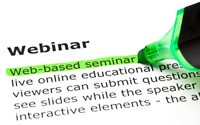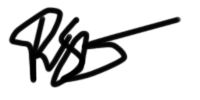My first Webinar (2009) resulted in about $1,500 in sales from 30 attendees…. …and I was very disappointed with that result. The main reason…. I had no frame of reference, no baseline or past performance to compare (just unrealistic expectations). However, I did have some help from a mentor who reviewed the results with me and helped me with corrections before the next one (good thing too).

The next one generated nearly 100k in sales.
Fortunately that number was closer to my expectations (unrealistic or otherwise). An expectation that was created by all the over-hyped marketing training I had purchased in the years prior. Oddly enough all that hyped up stuff actually helped.
I had a big money mindset vs. something more realistic and I really pushed myself to improve beyond the six-figure webinar mark. I didn’t know it at the time but all the statistics, like EPC (Earnings Per Click), were waayy off the charts (above average). If you want more information on my past projects go to my about me page. But times have changed and ….
Webinars are Very Different Now.
They have recently evolved into a very popular sales tool (over-used in some markets) and like many forms of marketing, it comes with it’s own unique set of challenges. One of the most recent challenges is the shear number of webinars being produced which also means more competition. Just like prime-time television shows, marketers are all competing for viewers (in this case attendees). On that note…. let’s move on to…
Seven (7) Key Lessons For Creating Webinars That Convert
Lesson #1 – Use a Methodology or Formula
It does not matter if you purchase a course or hire an expert to help you, what you start with will change. Eventually you will need to build your own webinar template. Your approach, your offer, the information you share during your presentation is going to change. You should learn something new each time you hold a live webinar and make small improvements. At a minimum you will need to develop checklists for the following areas:
- Invitation Email Sequence – How many will you send, what will they say and don’t forget the date / time (been there done that)
- Tracking and Analytics – Affiliate links, offer links, conversion metrics.. etc
- The Presentation – (Hint: should be similar to a sales letter). Grab my presentation guide if you want a proven and tested template.
- Replay Email Sequence – How many do you need, will the offer expire, what is the deadline, why is there a deadline.
- Ethical Bribe Email Sequence – If you offer a free download. This is a good way to followup with prospects and segment your list.
Lesson #2 – Capture Registrant Details
This can be interesting when dealing with JV traffic in particular. I have had some JVs tell me they don’t want me (or anyone else) to capture or “squeeze” registrants. I believe they are afraid of me, or anyone, abusing this new webinar list by sending other offers.
In this scenario, you should be attempting to build the value with your new registrants.. not spamming them. And when your registrations are from a JV partner, you are basically working on their behalf (they should want you to follow up). It is a non-issue when your driving your own traffic and you should still work to capture, tag and followup. So the lesson still applies regardless.
Lesson #3 – Build The Value
Give first, no one wants to be on a webinar to hear a sales pitch. Personally I expect a sales pitch at the end of the webinar and that is fine….. as long as the presenter has given me some value. This means sharing information that helps your attendee achieve some sort of result and/or valuable insights of some kind. Not everyone buys something the first time. Using Infusionsoft I have tracked subscribers who attended were on a list up to 6 months or more before making a purchase. If you want a little more detail on this subject and the format I use, you can copy my webinar presentation outline from the “Fool Proof Presentation Guide”.
Lesson #4 – Watch Your Numbers
Keep detailed statistics and track metrics. You have probably heard the saying ” If you can’t measure it, you can’t improve it”? Here are a few metrics you should try and track:
- Clicks vs. Registrations
- Registrants vs. Live Attendees (also called show up rate)
- Drop Outs ( if possible to track, when did they leave )
- Bribe Clicks vs. Bribe Downloads
- Offer Clicks vs. Offer Purchases
- Live Attendees (at CTA) vs. Purchases ( Attendee Conversions)
- Replay Views or Clicks Vs. Purchases
- Replay Statistics (views, length of view etc).
All this tracking can be tiresome. As a result, I have developed software to automate most of this. I wish I could share that with you but it is not really ready for public consumption yet.
Lesson #5 – Use Bonuses and Ethical Bribes
Proper use of bonuses will increase conversion and bribes can provide, in some cases, a second or third chance to present your offer, build trust and increase conversions. One of the most powerful marketing tactics you can use is the removal or expiration of a bonus (urgency). Our lizard brain has a powerful and uncontrollable fear of loss ( lookup Robert Cialdini’s book for more info).
Ethical bribes will give you another shot at capturing a lead and further segmenting your registrants. When presenting your ethical bribe, you have the option to survey the prospect either before or after download as well. In some cases you can even collect full address and phone numbers using multi-step forms (see my past post on generating higher quality leads for info).
Lesson #6 – Be Detailed (when it counts)
This was my biggest mistakes when I started.
Often times we assume that people know things just because it is common knowledge in our industry or profession (we have the curse of knowledge).Your audience will typically know less than you think, so you need to be prepared to speak at a beginner level. This is particularly true when selling information products that deal with complicated subjects.
One way to avoid this pitfall is to survey your attendees in advance and try to determine their level of knowledge on the upcoming subject. When positioned properly , while limiting your questions no more than 4-5 total, many of your prospects will happily complete the survey. If your struggling to get feedback try the ethical bribe option (bonus, ebook or other goodie) in exchange for taking the survey.
One final note on this, if your selling a course of some sort be sure to explain everything your buyer gets and the benefits as well (drills vs. holes). For the purpose of providing an example let’s pretend you have a four module E-course on facebook marketing. If module 2 is all about paid advertising then you will want to have a detailed explanation of what is covered in this module and also the benefits that this might bring. You certainly want to talk about what they will learn but the key is to include the benefit of that training module as well….” Once you complete Module 2, you will understand how to generate an unlimited number of leads using facebook advertising”.
Lesson #7 – Create a Compelling Call to Action
This is where the rubber meets the road and your hard work turns into sales and customers.
Dan Kennedy explains this best in his book “The Ultimate Sales Letter”. His advice is to visualize your prospect sitting in his easy chair, in a robe, smoking his pipe, reading the paper, feet by the fire and it is snowing outside. While comfy and warm he begins to read your sales letter, ad in the newspaper or watch your infomercial.
Your offer should be so compelling that he is motivated to fill out a written form, put it in an envelope, use a perfectly good stamp, put on his pants, jacket , boots and walk into the freezing cold to purchase whatever it is you might be selling. With that in mind here are a few things you can do to increase the likelihood that your prospect will take action:
- Create a strong guarantee
- Add social proof (testimonials, celebrity endorsements, case studies)
- Reasons to buy (examples of how prospects can immediate use the product, who the product is for, who it is not for)
- Offer Support (give people your email, phone or whatever they need to help them purchase or get help)
- Create urgency and scarcity ( bonus expires tonight, price increases tomorrow, limited to the first 10 who buy)
- How to order ( provide a clear explanation of how to order)
I could go on with added examples… but instead lets review my favorite call to action structure. If your ever felling lost during the close, just follow John Carton’s formula for closing the sale. this works over the phone, face-to-face and on webinars. Follow the Carlton call to action using these three easy steps:
- Here is what I got (your offer)
- Here is what it will do for ya (the benefit)
- Here is what you need to do next (how to order)
Pretty simple CTA don’t you think?
That’s all for now. I still have a few more tutorials to write to finish up my lead generation series so keep an eye out for that.

P.S. – You can download my fool proof presentation guide here (no email required)
P.P.S. – If you want to be notified of future posts just signup below or connect with me through various social sites or use the support link.
P.P.P.S. – If you enjoyed this article and the free presentation guide, please share (thanks in advance).

